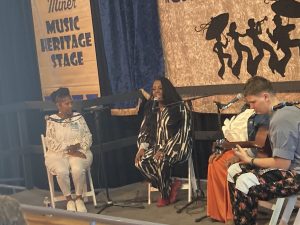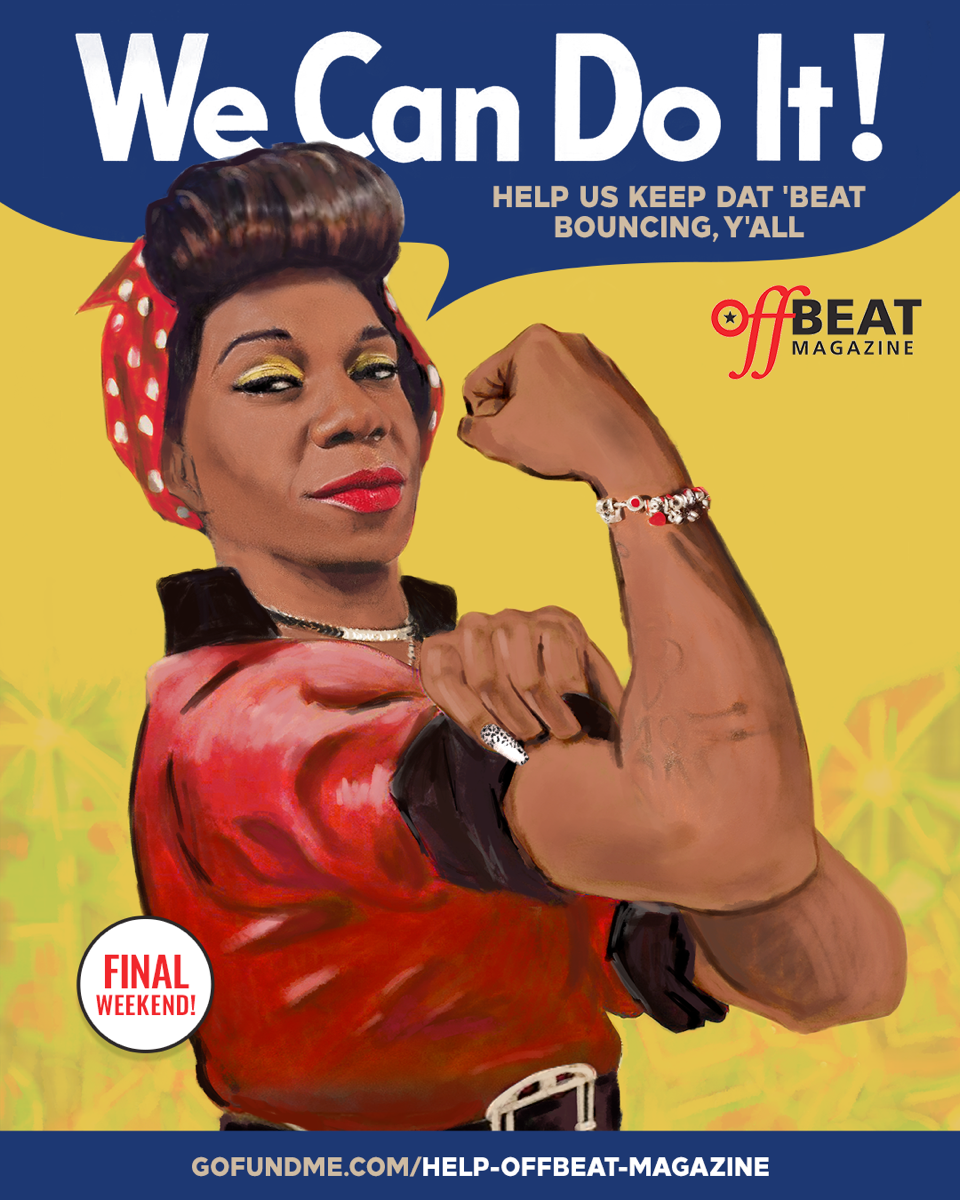Review from John Wirt Jazz Fest Day 8: Sunday, May 4, 2025
Yvette Landry and the Jukes
Opening a beautiful final Sunday at Jazz Fest’s Fais Do-Do Stage, Yvette Landry from Breaux Bridge led her mostly Acadiana band, the Jukes, through a set made for a southwest Louisiana dancehall. Simultaneously Landry delivered on her promise of variety, romping through Cajun music, slow-dance swamp pop, New Orleans rhythm-and-blues and rockabilly and country music.
A lively presence strumming her guitar, Landry also performed original compositions written by band members. The set’s standards included Wanda Jackson’s “Let’s Have a Party,” Chuck Berry’s “Johnny B. Goode” and a sweetly sung rendition of “Waltz Across Texas.”
Imaginatively, Landry and the Jukes reinvented Berry’s rock and roll classic, infusing it with a classic New Orleans rhythm and blues sound. The city’s R&B heritage resurfaced again in the set with a fun performance of Oliver Morgan’s classic “Who Shot the La La.”
Keeping the good times rolling, Landry’s original song, “Blue Moon Girls,” took the crowd to the Blue Moon Saloon. The song celebrates Louisiana’s joie de vivre via a particular group of young ladies who frequent the Lafayette music venue, where they have a ball drinking, smoking and, of course, dancing.
Although the morning audience at the Fais Do-Do Stage more often swayed than danced, Landry and the Jukes gave the crowd plenty of opportunity to waltz, two-step and rock-step. A hot take on one of the Carl Perkins songs recorded by the Beatles, “Slow Down,” would have burned any juke down. “Richard’s Boogie Woogie,” an original instrumental written by Jukes pedal steel guitarist Richard Comeaux, was another roadhouse rocker.
Throughout the show, Landry’s Jukes band members played many solos. A good thing when the band features saxophonist Derek Huston, piano player Eric Adcock, fiddler Beau Thomas, bassist Chris French and drummer Gary Usie.
Ledisi
New Orleans-born, Grammy-winning singer, songwriter, actress, producer and music educator Ledisi thoroughly engaged her Sunday afternoon audience at the Music Heritage Stage with words and music.

Ledisi interviewed by Karen Celestan. Photo by John Wirt
Ledisi’s interview followed her Saturday tribute to one of her inspirations, Nina Simone, at the Jazz Test. Interviewer Karen Celestan hit several of the many stellar accomplishments in Ledisi’s career, including her recent showstopping performance of “Lift Every Voice and Sing” at the Super Bowl in New Orleans. As an actress, Ledisi has portrayed no less than Mahalia Jackson, Patti LaBelle and Gladys Knight.
Before her move to California at 10 years old, Ledisi lived in New Orleans with musician parents. Her mother listened to country music stars Patsy Cline and Willie Nelson, she said, but her music education was in the classical realm. More importantly, Ledisi told the full house at the Music Heritage Stage, she absorbed enough of New Orleans’ musical gumbo to be the eclectic artist she’s become.
“I’m so grateful to be from this city, because you can listen to so many kinds of music,” the singer told Celestan.
The opportunity to record a variety of music compelled her to launch her own record company, Listen Back Records. “I sing life, I don’t sing genre,” she explained. “Everything I sing, I’m thinking about my life, my roots.”
Accompanied by guitarist Xavier Lynn and backup vocalist Sara Williams, Ledisi sang two songs during her interview. First came a tour-de-force interpretation of Beatle George Harrison’s “Here Comes the Sun.” Ledisi, a singer with remarkable range, inspired cheers when she soared to her upper register. Her second selection, an original titled “Alright,” is a song of consolation and encouragement. Singing, scatting and growling, she again proved herself to be an artist who radiates joy.
D.K. Harrell
A 27-year-old singer-guitarist from north Louisiana, D.K. Harrell is a rising star. Appearing with his Baton Rouge-based band Sunday at the Blues Tent, Harrell confidently stepped into the traditional electric blues man role that’s previously been dominated by the likes of B.B. King and Buddy Guy.
Harrell’s singing and guitar playing, most of all recall the late B.B. King. That resemblance shows up in his guitar solos’ sweet, clear tones and shimmering vibrato. It’s also there in his declarative vocal style. Wearing a cherry red blues man suit, Harrell dressed the part of an old-school blues man, too.
As adept as Harrell is at conventional blues, funk, soul and gospel come naturally to him as well. Setting his guitar aside, Harrell’s showmanship manifested itself most of all the gospel-oriented material. His first album from Chicago’s famous blues label, Alligator Records, arrives in June.
Sonny Landreth
Sunday’s big day at the Blues Tent included rising young blues artists D.K. Harrell and Mississippi’s Christone “Kingfish” Ingram as well as Lafayette slide guitar master Sonny Landreth. A Jazz Fest veteran, Landreth’s icy, slicing slide sound belongs exclusively to Landreth.
The large video screens on each side of the Blues Tent stage gave Landreth’s audience a close-up look at his unconventional guitar technique. While his slide is gliding over his Stratocaster neck, he picks the instrument’s strings with a thumb pick and bare fingers. At times the fingers seemingly dance on the strings. Other times Landreth employs his right hand to hammer and muffle the strings.
A singer and guitarist, Landreth’s performance included two of his signature compositions, “Congo Square” (also recorded by the Neville Brothers) and the autobiographical South of I-10.” His set’s instrumental highlights included “Firebird Blues,” a piece dedicated to and in the style of the late Johnny Winter.—John Wirt

Tom Jones, Saenger Theatre, Sunday, May 4, 2025, at 8 p.m.
Review by Brett Milano
Tom Jones’ Sunday night show at the Saenger amounted to one last Fest headline set. He largely repeated the show he played at the Fair Grounds two years ago, but it had enough depth and nuance to warrant re-exploring. And if you don’t associate depth with Tom Jones, you’re out of date: His last few albums found him re-invented as an artist who explores the most challenging of time and mortality-themed songs. In short, his days of dodging thrown panties onstage are largely over (though we did see one fan wielding hers in the front rows).
Accordingly, his set opened with stripped-down versions of “I’m Growing Old” and Leonard Cohen’s “Tower of Song,” the band only kicked in on a blues groove when he took on the ominous sentiments of Dylan’s “Not Dark Yet” (“…but it’s getting there”). The set’s centerpiece was an existential blues by the late Terry Callier, “Lazarus Man.” When he did the oldies—“What’s New Pussycat,” “Delilah” and “It’s Not Unusual”—he reimagined them with acoustic guitar and accordion. And when he did swaggering tunes like “Sex Bomb” and Prince’s “Kiss” well, they still swaggered. Jones has changed, but not all that much.
And that’s the wonder of a Tom Jones show: The man, who turns 85 next month, exudes joie de vivre even while staring down mortality. He may do less dancing nowadays but his voice has lost nothing, and he has a terrific blues-rock band behind him (I recognized bassist Dave Bronze from Trower and Clapton). He encored with “One Hell of a Life” (by the Welsh songwriter Katell Keaneg) and pointed out that he’s still having one. The last Jazz Fest show wrapped up with a vintage rock & roll number; this time there were two—“Johnny B. Goode” and “Great Balls of Fire”—and for that moment we were back in his Vegas heyday, complete with a story about his hanging out with Elvis.
Nor did this show feel like a wrapping-up. Early in the show, he pointed out someone in the audience who was heard to say that Jones “still had it.” And he shot back, “Thank God for that. And I intend to hold onto it.”




